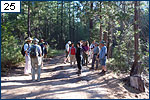
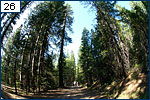
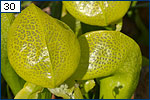
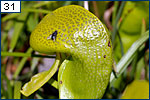
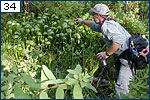
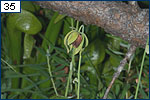
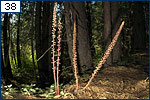
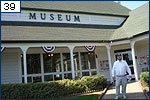
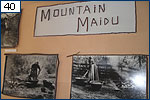
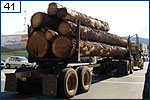
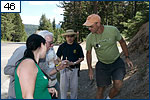
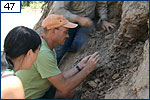
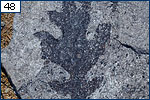
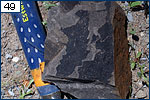
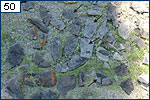
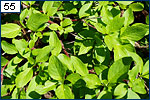
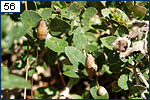
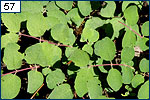
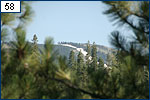
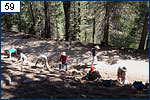
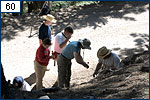
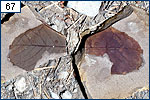
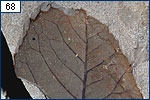
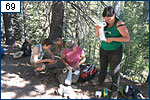
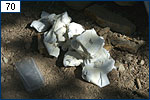
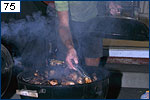
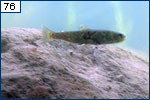
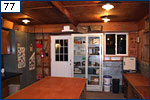
Diane Erwin: Paleobotany field trip to the Sierra Nevada
By UCMP museum scientist Diane Erwin, August 5, 2006
Stop 1: The Butterfly Valley hike
This was going to be a busy day. We started with a morning excursion to the Butterfly Valley Botanical Area (pdf) near Quincy. Even though the trip was optional, it was great to see that most of the group woke up for the early morning hike led by James Belsher-Howe, a botanist with the Mt. Hough Ranger District of the Plumas National Forest. The Butterfly Valley is named for the shape of the valley as seen from the air and best known for the large populations of carnivorous plants that grow in this area. The preserve supports over 500 species of trees and herbaceous plants that include the carnivorous California pitcher plant or Cobra lily, bladderworts, and sundews, as well as orchids, lilies, and ferns.
                            |
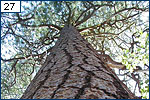 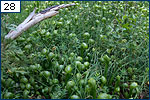 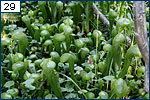 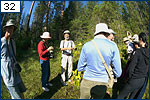 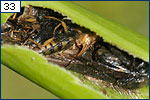 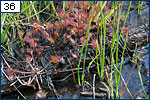 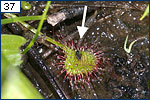 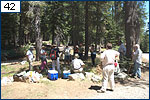 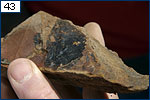 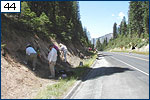 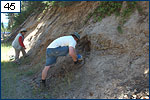 |
For all their majesty, the conifers play second fiddle to the Valley's darlings (pardon the soon-to-be-apparent pun), the insectivorous California pitcher plant, Darlingtonia californica (photos 28 and 29). This species belongs to the pitcher plant family Sarraceniaceae and there is only one species in the genus. Darlingtonia is native to the mountains of Northern California and Southern Oregon. The leaves are highly modified into a hollow elongate tube that terminates in an inflated hood-like structure subtended by two narrow leafy projections attached near the "mouth" (opening at the top of the leaf tube), which is hidden under the hood (photo 30, right). It is these projections and the area around the "mouth" where a nectar-like substance is produced, attracting flying and crawling insects (photo 31), drawing them into the mouth and down inside the "throat." Inside the tube the insects eventually meet their demise as they fall into the bacteria-rich water that awaits inside. In Darlingtonia, it is actually the bacteria which breaks down the insects and not digestive enzymes secreted by the plant as in other insectivorous plants. It is also thought that the thin, translucent areas which cover the hood and continue a short distance down the back of the tube give insects the illusion they are windows through which they can make their escape.
James invited the group to split open a Darlingtonia stem to see what was inside (photo 32, left), and as expected, the remains of previous meals were revealed (photo 33). James also pointed out the unobtrusive flower stalks of Darlingtonia (photo 34, right), which can easily be missed, but not by our James McConnell (photo 35).
The sundew family Droseraceae is another group of insectivorous plants living in the boggy areas of the Butterfly Valley Botanical Area and we had the good fortune to come upon a "grove" of roundleaf sundew, Drosera rotundifolia, growing on and around a water-soaked log (photo 36, left). Like Darlingtonia, Drosera produces flowers at the end of a long stalk, but it differs in that Drosera species secrete digestive enzymes to break down insects and extract the nutrients they need. In photo 37, a fly will soon become a meal for this Drosera.
Growing alongside the Bog Road under the ponderosa pines, we found Pterospora andromedea Nuttal (photo 38, right), another member of the Indian pipe subfamily Monotropoideae within the family Ericaceae. Note that some classifications treat this group as a family, the Monotropaceae. It is a Sierra Nevada native and has a number of common names including woodland pinedrops, beechdrops, giant bird's nest or giant pinedrops. This plant is endangered in New York and Michigan and threatened in Wisconsin and Vermont. Pterospora lacks chlorophyll and it is still not clear if they are saprophytes or parasites. They get their nutrients through the fungus that has a mutually beneficial mycorrhizal relationship between it and the roots of conifer trees. Since there is no direct evidence that Pterospora is parasitizing the tree roots, many consider it a saprophyte, whereas others see it as a parasite on the fungus.
Trip participants Virginia and Howard Friedman opted to visit Quincy's Plumas County Museum (photo 39) instead of going on the Butterfly Valley hike. There they saw many displays about the Maidu Indians (photo 40), some of the earliest inhabitants of the northern Sierra region and today's Plumas County. While walking down Quincy's main street, Virginia and Howard noted that large, timber-hauling semitrucks (photo 41, left) were a common sight. Active logging operations in the Plumas National Forest contribute to Quincy's economy.
Stop 2: The Gold Lake locality
Before visiting the Gold Lake locality, the group gathered for a picnic lunch. Afterwards, trip leaders Jeffrey Myers, Lenny Kouwenberg, Howard Schorn, and Diane Erwin talked about the geologic history of, and current research being done on, the Gold Lake and other Miocene Sierran paleofloras in the area (photo 42, left). Participants were privy to some of the research being done on these Miocene paleofloras, the results of which are in the early stages of publication. The current debate about the timing of the northern Sierra Nevada uplift was among the trip's themes. Lenny described how she and her colleagues, Jennifer McElwain (University College Dublin in Ireland) and Julie Broughton (currently finishing up her Ph.D. dissertation at UC Santa Barbara on the Gold Lake and nearby Mohawk floras), are using the density of stomata on the leaves of the Gold Lake fossil oak species Quercus pseudolyrata to reconstruct paleoelevation by determining paleo-CO2 levels. Learn more from two posters by Lenny and her colleagues: (1) "The effect of light intensity and temperature changes on the stomatal and epidermal morphology of Quercus kelloggi: implications for paleoelevation reconstruction" (pdf); and (2) "The potential of stomatal frequency analysis as a paleo-altimeter" pdf. A few years ago, Howard Schorn suggested to Jennifer that she use the California black oak, Quercus kelloggii, the modern relative of Q. pseudolyrata, as a test of their quantitative method. Howard suggested black oak because this particular species grows throughout the northern Sierra Nevada from the lower elevation foothills up the western Sierran slope into the subalpine coniferous forest. The results from Lenny and Jennifer's earlier work showed that the method worked. This work is providing further evidence that the northern Sierra Nevada did not undergo major uplift during the late Cenozoic, but rather has stood as high as it does today at least since the Cretaceous.
The plants at the Gold Lake site are preserved as black compressions in light to dark gray, fine- to coarser-grained sandstones of the Bonta Formation. These fossils are especially valuable to paleobotanical study because the leaf cuticles are well preserved. In photo 43, the fossilized cuticle is the black coaly material flaking off in some places. So at the site, the group spread out along the hillside, carefully sampling (photos 44 and 45), while Russell Shapiro made notes on the geology from the other side of the road (photo 44, arrow).
Jeffrey Myers (in baseball cap) found a number of good specimens at the site (photos 46 and 47, right), including the Quercus pseudolyrata oak leaf in photo 48. The Gold Lake leaves are usually fragmentary so this complete leaf of Q. pseudolyrata is an exceptional find. The specimen is of special value to Lenny Kouwenberg as she will be using it in her paleoelevation research. Some leaf fragments of the Gold Lake sycamore (photo 49), similar to the fossil species Platanus dissecta, were also found — Lenny will be looking at the cuticles of these to determine their usefulness in her research as well.
Howard Schorn and Diane Erwin included the Gold Lake, Mohawk, and Webber Lake floras in a 1999 study looking at the floristic composition and taphonomic aspects of the palynofloras (pollen and spores) as a way to compare the responses of Neogene paleofloras to their physical settings in the areas of present-day west-central Nevada and the northern Sierra Nevada. The fossil palynomorphs from the Gold Lake and Mohawk showed a much higher degree of abrasion than did the pollen assemblages from Nevada. This seems to support the differences in the depositional environments — the Gold Lake and Mohawk pollen was preserved in debris-dammed lakes on the western Sierran slope, whereas deposition of the Miocene west-Nevada fossil palynofloras was in large quiet lakes that formed on the high plateau of western Nevada. More recent work by Wagner et al. (2000), Garrison et al. (2003) and Garside et al. (2005) have further clarified our understanding of the Cenozoic geologic setting in the northern Sierra Nevada and the age of the paleofloras.
Greg Retallack spread out his specimens for Lenny to select ones relevant to her research (photo 50). The most readily identifiable are leaf fragments of the sycamore, Platanus (arrows). Preparation of the cuticle aids in identifying those fragments in which the venation pattern is not clearly visible.
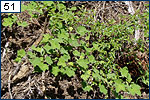 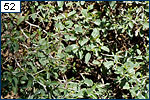 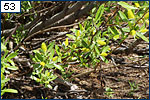 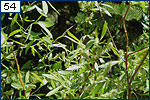 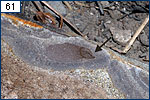 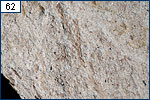 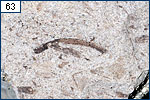 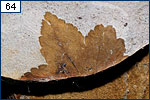 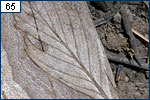 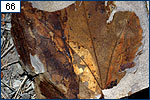 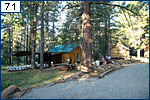 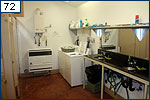 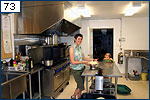 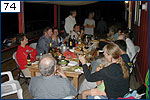 |
• Currant, Ribes sp. (photo 51, left), a member of the Grossulariaceae and one of many extant plants growing near the Gold Lake site that have long fossil histories extending back to the Paleogene.
• Ceanothus cf. cordulatus, Mountain Whitehorn (photo 52).
• One of two species of willow, Salix sp. (photo 53), that currently grow at the Gold Lake locality.
• The leaves of the second species of Salix sp. (photo 54) has smooth margins, whereas leaves of the other species are finely serrated (toothed).
• The dogwood growing at the Gold Lake site (photo 55, right) appears to be most similar to the red osier dogwood, Cornus stolonifera. The young twigs of this species have a scaly, reddish bark and the nodes are ringed.
• The brown nut-like structures on this huckleberry oak, Quercus vaccinifolia (photo 56), are insect galls. Many extant oak species play host to a number of gall-inducing insects, just as the fossil members of this genus did.
• The mountain snowberry, Symphoricarpus oreophilus (photo 57), is a member of the honeysuckle family, Caprifoliaceae.
Stop 3: The Webber Lake locality
From the Webber Lake site, persistent snow can be seen on distant hills (photo 58), even this late in the summer. Today, the Webber Lake fossil locality is near 6800 feet elevation and is in a transition zone between the Sierran montane forest (lower montane) and the upper montane-subalpine forests dominated by pine and fir. Growing near the site is the western white pine (Pinus monticola), which occurs at higher elevations in the Sierra. A fossil species similar to P. monticola has also been found in the Webber Lake fossil flora.
The Webber Lake paleoflora, currently under investigation by UCMP and associates, is Miocene in age and preserved in fine-grained lacustrine shales.
Photo 59 shows the group spread out, splitting apart the shales. Several specimens were collected in a short period of time and the group kept the trip leaders busy trying to identify their fossils (photo 60). Initial study of the Webber Lake leaf compressions, pollen, and spores attests to its diversity of both hardwoods and conifers. Unlike the older Eocene floras visited, the composition of the younger Miocene Gold and Webber Lake floras show plants adapted to a cooler climate.
Some of the more significant specimens included:
• A winged seed from a spruce, Picea (photo 61, left). Spruce winged seeds typically have an indentation in the seed body (arrow).
• A small fragment of foliage belonging to the cypress family Cupressaceae (photo 62).
• Photo 63 is of a "conifer needle (Pinaceae)" — accurately identifying conifer needles to genus can be a challenge, especially when they are fragmentary and incomplete, so this is the best we could do as far as classification.
• A nice partial leaf of Ribes sp. (photo 64), a member of the currant or gooseberry family, Grossulariaceae. Elizabeth Hermsen recently completed her revision of the fossil record of Ribes and related taxa for her Ph.D. dissertation while at Cornell. She found that many of the named fossil species were invalid.
• A leaf impression from a fossil species of Cercocarpus sp. (photo 65), the mountain mahogany, which is a member of the rose family, Rosaceae. Note the left distal portion of the leaf has been grazed by a margin feeder.
• An incomplete leaf of a fossil sycamore, Platanus (photo 66).
• Here's part and counterpart (when collecting, it is always important to keep track of both the part and counterpart of a specimen) of a fossil toyon or Chistmas-berry, Heteromeles sp. (photo 67, right), in the family Rosaceae. This specimen also shows signs of insect herbivory. In the close-up view in photo 68, the wound tissue (dark edge) along the upper left margin of the leaf can be clearly seen. This was produced by the plant in response to a margin feeder. The circular area on the lower right may be remnants of a gall.
In the late afternoon, it was time to quit for the day, so group members carefully wrapped the fossils in toilet paper (photo 69). When the job was done, it became clear that we had collected a fair number of significant specimens (photo 70). Our last stop for the day was the UC Berkeley Sagehen Creek Field Station, where we'd be lodging for the night.
At the Sagehen Creek Field Station
Following a long day on the road and in the field, the group checked in at the Sagehen Creek Field Station's Upper Camp facilities (photo 71). Although Sagehen users must bring in and take out their bedding, towels, food, etc., the camp provides heated cabins with beds, bathhouses with showers, flush toilets, laundry facilities (photo 72), and a fully equipped kitchen (photo 73). For many, "camping" at Sagehen Creek was most enjoyable and at the top of their highlight list.
Dinner was a wonderful barbecue prepared by some of the trip leaders (photo 74), with Jeffrey Myers graciously manning the grill (photo 75).
Being a field research station, participants had an opportunity to investigate some of Sagehen Creek's facilities. James McConnell took this image of a trout (photo 76) through a window in the Fish Observation Building. The windows actually look out into the main channel of Sagehen Creek. To see and learn more about the fish, as well as research being done on the Sagehen Creek ecosystem, visit the Field Station's website. Thanks to station manager Jeff Brown, the Sagehen Creek Botany Lab (photo 77) was up and running so participants could examine the station's herbarium of pressed plants (gray metal cabinets) collected from the preserve and throughout the Sierra Nevada. See the Field Station's complete list of plants.
And so concluded a very full Day 2. Tomorrow's first stop will be the Soda Springs locality.
Photos 25, 26, 28, 30-33, 35, 37, 38, 42, 43, 45-50, 58-71, and 74-76 by Jim McConnell; 29, 36, 72, 73, and 77 by Yuri Panchul; 27, 34, and 44 by Jeffrey Myers; 39-41 by Virginia Friedman; 51-57 by Diane Erwin.